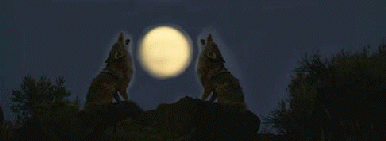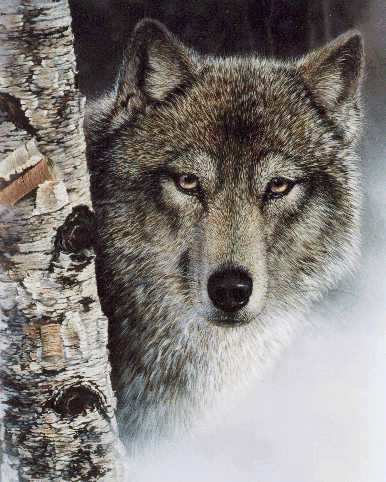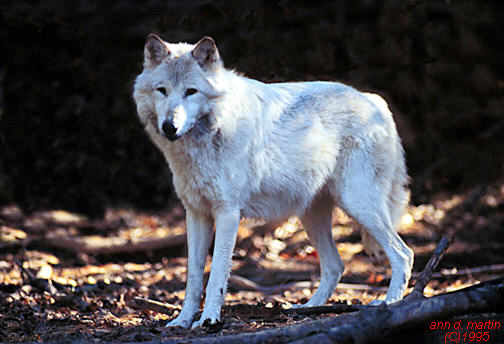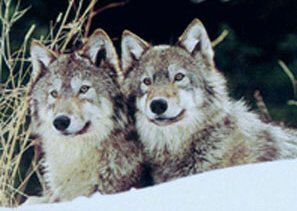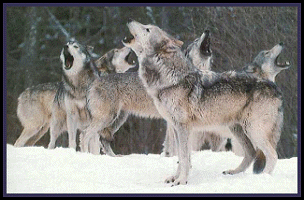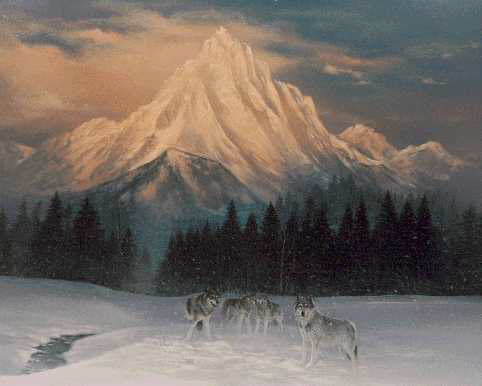

Welcome My Friends
I Hope You Will Enjoy Your Visit

Close Encounters
By_Maija


~~The Way The Wolf Communicates~~
Many of us think of communication only as writing or talking to each other. Those are two good ways to communicate, which we humans use every day.Wolves communicate in many ways.
One of the most interesting and important ways wolves communicate is through "body language".Wolfpacks are highly organized,and the wolves in the pack live by certain "rules".The biggest rule is that there are leaders and there are followers.The leaders of the pack are known as the Alpha Male and the Alpha Female,the father and mother of the pack.They are usually the biggest,strongest and the smartest wolves in the pack.They are usually the only members of the pack to produce pups.
Most of the time the other pack members do what the Alpha pair want them to do.This is called dominance.The Alpha pair communicates their dominance with their bodies.They carry their tails high and stand tall.The less dominate wolves keep their tails low and often lower their bodies while pawing at the higher ranking wolves.If two wolves have a disagreement,they may show their teeth and growl at each other. Both wolves try to look as fierce as they can.
Usually the less dominate wolf,the "subordinate one",gives up,the wolf rolls over on its back and the other wolf stands over it.You can see that following the dominance "rules"helps keep the wolves in a pack from fighting among themselves and hurting each other.

The Wolves Of Yellowstone Park
Wolf population in Yellowstone is growing
Despite wolf extermination order last December, Yellowstone's wolf project is "business as usual"
By Shelli Johnson
The following story was written and printed in the Yellowstone Journal in May, 1998
Despite U. S. District Judge William Downes' ruling last December that Yellowstone's wolf reintroduction program is illegal, the parkÕs wolf population is doing well.As of early May, there were 82 wolves in Yellowstone and biologists working on the project estimated that 40-50 pups will be born during the spring season. If this is the case, Yellowstone's wolf population would grow to well over 100 animals.
The wolves comprise 12 "groups," which include eight packs, said Deb Guernsey, administrative assistant for Yellowstone's wolf recovery project. However, two of the "packs" are simply pairs consisting of an alpha male and female.
By early May, five packs had denned and two other pairs of wolves were showing signs of denning, and the alpha female of the Nez Perce pack, which is currently in a pen, had a litter of five pups. Wolf #27, the original alpha male of the pack had depredated on livestock three times near Dillon, Mont., last year and as a result was destroyed. The remaining wolves in his pack were placed in the pen.
"They were accomplices," said Guernsey. "They've had a couple of strikes so if they leave the park again they will probably be removed from the population. The good news, though, is now that the female in the group has given birth to pups, they should stay in the area when they're released the first part of June."
PUPS BEING BORN
Wolves breed in February and whelp between mid-April and mid-May, said Guernsey. The females begin looking for dens one to three weeks prior to giving birth. Yellowstone's wolves tend to choose south-facing slopes near water for their den sites.
"They'll use various things to construct a den," said Guernsey. "They'll dig underneath boulders. They'll use hollowed-out logs or dig underneath roots of a tree" to construct a place in which to give birth to pups.The dens are only as big as they need to be, and sometimes wolves will enlarge holes used by other animals to construct their dens. There are usually two chambers in the den, said Guernsey. According to David Mech's The Wolf, the den's entrance may measure 14-25 inches in diameter and is usually oval in shape and the den may have several entryways and passageways. The tunnel may be of the same size but usually extends six to 14 feet into the ground. At the tunnel's end is an enlarged chamber for the newborn pups.
About three weeks prior to whelping, the female remains near the den site, and usually one day prior to the birth, she confines herself to the den. During birth, the puppies are born at irregular intervals, sometimes spaced an hour apart.
Newborn pups are blind and deaf, darkly furred. Each newborn pup weighs about one pound. When pups are three weeks old, they walk well and may romp and play near the den's entrance. During the summer, the den is the wolves' social center because most activities occur at or near the den site.
"The mother spends most of her time in the den nursing the puppies," she said. "Occasionally the female will come out and lie in front of the den, but won't go far away. The other pack members will bring her food and (often will) regurgitate it to her so she can get nourishment for the puppies. And when the pups are bigger and outside of the den, the older members of the pack will babysit while the mother goes to get a drink of water."
HUNDREDS OF VISITORS SEEING WOLVES
Guernsey said hundreds of visitors see wolves in Yellowstone and that Lamar Valley is the place to view them. The Druid Peak pack, which is just one pack that inhabits Lamar Valley, is often visible.
Following is a brief overview of Yellowstone's wolves:
The Crystal Creek pack inhabits the Pelican Valley region of Yellowstone and consists of eight wolves.
The Leopold pack inhabits the Blacktail Plateau region of Yellowstone and consists of nine wolves.
The Rose Creek pack is Yellowstone's largest group and inhabits the western portion of Lamar Valley and consists of 14 wolves.
The Druid Peak pack, which is Yellowstone;s most visible wolf pack, inhabits the Lamar Valley and consists of eight wolves.
The Chief Joseph pack consists of six wolves and inhabits the northwest corner of Yellowstone.
Because the Chief Joseph II "group" consists of an alpha female and two subordinate wolves, it is not an official pack. The alpha and one of the other wolves inhabits the northern region of Yellowstone, while the location of the third wolf is unknown.
The Soda Butte "group" consists of eight wolves, of which there is only an alpha female and seven other wolves. Because there is not an alpha pair, this group is not an official pack. However, Guernsey says there is a male of breeding age in the group, but the alpha female has shown some avoidance toward him. This group inhabits the Thorofare region of Yellowstone.
The Thorofare "group" consists of five yearling wolves that inhabit a region east of Yellowstone. According to Guernsey, the social status of each of the wolves in this group is unknown.
The Washakie "group" consists of six wolves, including an alpha female and five yearlings. They currently inhabit the DuNoir Valley, near Dubois,Wyo.
The Nez Perce pack is currently being held in a pen due to livestock depredations last year. The female of the group recently gave birth to five pups. According to Guernsey, the pack will be released in early June and is expected to stay in the region due to the new litter of pups. Known as the Nez Perce pair right now, this pair consists of an alpha male and female that inhabits an area near the pen that is currently holding other members of the original Nez Perce pack. At press time, this pair was showing signs of denning.
An alpha female and male comprise the Sunlight pair, which inhabits the northeastern corner of Yellowstone. At press time, this pair was also showing signs of denning. A two-year-old loner female wolf is currently missing and her location is unknown, and there are currently six wolves that previously dispersed from their original packs. These wolves are unaccounted for because they are not radio-collared and therefore cannot be monitored.
Recommended reading:
The Wolves of Yellowstone, by Mike Phillips and Doug Smith, wolf biologists working on the restoration project in Yellowstone.
The Wolf, by David L. Mech.
Wolf Wars, by Hank Fischer.










Click On The Baby Wolf To See More Wolves

Click For Updates On The Wolves Of Yellowstone
Home

Sign My Guestbook
View My Guestbook
View my old Guestbook.
View
Feather Bars By_

This Page Hosted By Get Your OwnFree Homepage
Get Your OwnFree Homepage

